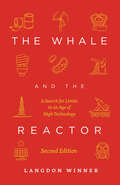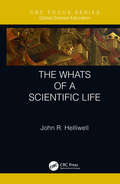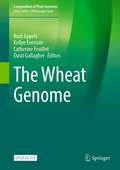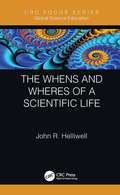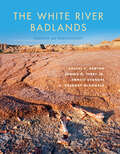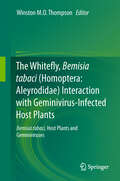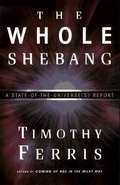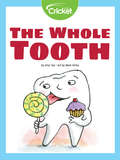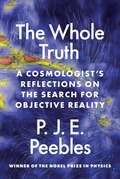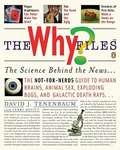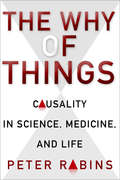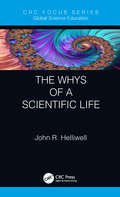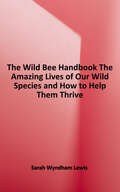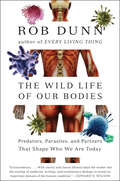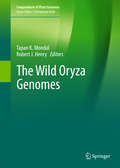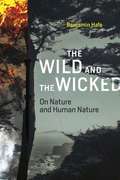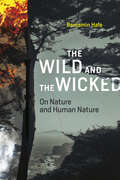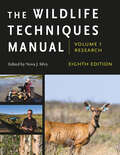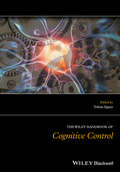- Table View
- List View
The Whale and the Reactor: A Search for Limits in an Age of High Technology, Second Edition
by Langdon Winner“In an age in which the inexhaustible power of scientific technology makes all things possible, it remains to be seen where we will draw the line, where we will be able to say, here are possibilities that wisdom suggest we avoid.” First published to great acclaim in 1988, Langdon Winner’s groundbreaking exploration of the political, social, and philosophical implications of technology is timelier than ever. He demonstrates that choices about the kinds of technical systems we build and use are actually choices about who we want to be and what kind of world we want to create—technical decisions are political decisions, and they involve profound choices about power, liberty, order, and justice. A seminal text in the history and philosophy of science, this new edition includes a new chapter, preface, and postscript by the author.
The Whats of a Scientific Life (Global Science Education)
by John HelliwellThis book completes a scientific life trilogy of books following on from the Hows (i.e. skills) and the Whys is now the Whats of a scientific life. Starting with just what is science, then on to what is physics, what is chemistry and what is biology the book discusses career situations in terms of types of obstacles faced. There follow examples of what science has achieved as well as plans and opportunities. The contexts for science are dependencies of science on mathematics, how science cuts across disciplines, and the importance of engineering and computer software. What science is as a process is that it is distinctly successful in avoiding or dealing with failures. Most recently a radical change in what is science is the merger of the International Council of Scientific Unions and the International Social Sciences Council. Key Features: Dissects what is science and its contexts Provides wide ranging case studies of science and discovery based directly on the author’s many decades in science The author has outstanding experience in mentoring and career development, and also in outreach activities for the public and students of all ages The world of science today involves a merger of ‘the sciences’ and the ‘social sciences’
The Wheat Genome (Compendium of Plant Genomes)
by Catherine Feuillet Rudi Appels Kellye Eversole Dusti GallagherThis open access book provides the first comprehensive coverage of the wheat genome sequence since the publication of the draft and reference sequences for bread wheat and durum wheat. It presents an overview and all aspects of the gold standard sequence of the bread wheat genome, IWGSC RefSeq v1.0 and its subsequent improvements through 2022 (IWGSC RefSeq v2.1), as well as the sequencing of multiple elite wheat varieties, durum wheat, and ancient wheat. The book provides a broad and extensive review of the resources, tools, and methodologies available for exploiting the wheat genome sequence for crop improvement and studying fundamental questions related to the structure, function, and evolution of the wheat genome. Wheat (Tritcum aestivum L.) is the most widely grown crop in the world, contributing approximately 20 percent of total calories and more protein in human diets than any other single source. This book is useful to students, teachers, and scientists in academia and industry interested in gaining an understanding of the wheat genome and its application as well as plant scientists generally interested in polyploid plant species.
The Whens and Wheres of a Scientific Life (Global Science Education)
by John R. HelliwellBig questions and issues arise about the role of the scientific life in our society and in our world. These have to do with trusting science at all, or with the wider roles of the scientist. The Whens and Wheres of a Scientific Life serves as an epilogue to author John R. Helliwell’s scientific life trilogy of books on the Hows (i.e. skills), the Whys and the Whats of a scientific life. When and where questions play a big role in major science facility decisions. When and where also play a big role in controlling a pandemic like the coronavirus COVID-19. The consequences of such work and the role science plays in society are discussed in this book. Key Features: Discusses when and where we can make new and better things happen and make new discoveries. Explains whens and wheres as examples in basic science and explaining these to the public User friendly and concise, this text provides a wide range of examples of science and discovery The author has diverse experience in career development, teaching and research The importance of open data to the reproducibility of science are described
The Where, The Why, and The How: 75 Artists Illustrate Wondrous Mysteries of Science
by Matt Lamothe Julia Rothman Jenny VolvovskiIn this New York Times bestseller, “you’ll see star births described in pen and ink, antimatter realized in collage, and a hand-painted black hole” (Discover Magazine).A science book like no other, The Where, the Why, and the How turns loose seventy-five of today’s hottest artists onto life’s vast questions, from how we got here to where we are going. Inside these pages some of the biggest (and smallest) mysteries of the natural world are explained in essays by real working scientists, which are then illustrated by artists given free rein to be as literal or as imaginative as they like. The result is a celebration of the wonder that inspires every new discovery. Featuring work by such contemporary luminaries as Lisa Congdon, Jen Corace, Neil Farber, Susie Ghahremani, Jeremyville, and many more, this is a work of scientific and artistic exploration to pique the interest of both the intellectually and imaginatively curious.“A work of art . . . Pop-science buffs will find the subject matter intriguing, and those who admire graphic novels or comic art will find a plethora of eye candy.” —Publishers Weekly (starred review) “The artists created whimsical illustrations, and the scientists responded with thoughtful essays.” —Smithsonian.com“Seventy-five contemporary artists such as Jacob Magraw, Jen Corace, and Patrick Kyle were commissioned to create the book’s original artwork, leading to a huge variety of visual styles throughout. Some illustrations are, like the front cover pictured above, akin to those of a beautified textbook, but the most are simply works of art; literal, metaphorical, or satiric imagery to accompany the text.” —The Verge
The White River Badlands: Geology and Paleontology (Life of the Past)
by Rachel C. Benton Dennis O. Terry Jr. Emmett Evanoff H. Gregory McDonaldThis guide to the South Dakota region that houses the world&’s richest fossil beds does &“an excellent job of presenting the current state of knowledge&” (Choice). The forbidding Big Badlands in Western South Dakota contain the richest fossil beds in the world. Even today these rocks continue to yield new specimens brought to light by snowmelt and rain washing away soft rock deposited on a floodplain long ago. The quality and quantity of the fossils are superb: most of the species to be found there are known from hundreds of specimens. The fossils in the White River Group (and similar deposits in the American west) preserve the entire late Eocene through the middle Oligocene, roughly 35-30 million years ago and more than thirty million years after non-avian dinosaurs became extinct. The fossils provide a detailed record of a period of abrupt global cooling and what happened to creatures who lived through it. This book is a comprehensive reference to the sediments and fossils of the Big Badlands, and also touches on National Park Service management policies that help protect such significant fossils.Includes photos and illustrations&“A worthy successor to the work of O&’Harra.&” —Journal of Vertebrate Paleontology
The Whitefly, Bemisia tabaci (Homoptera: Aleyrodidae) Interaction with Geminivirus-Infected Host Plants
by Winston M.O. ThompsonThe book presents a chronology of events of B. tabaci and geminiviruses, and an overview within the Caribbean and Latin America. The pathosystems involving Tomato yellow leaf curl virus, Cotton leaf curl virus and the cassava mosaic viruses are discussed. Data is presented on amino acid concentrations influencing B. tabaci and thus serves the basis for holidic diets. The essential molecular techniques for B. tabaci identification and classification are included with factors to consider for appropriate applications; an essential working guide for graduate students and researchers in the molecular field. Excellent photos portray symptoms of geminivirus-infecting crops: tomato, cotton, cassava, legumes and cucurbits; an important guide for researchers and growers. The novel insecticides, their mode of action and specificity; emphasize the applications of these within IPM programs.
The Whole Shebang: A State-of-the-Universe(s) Report
by Timothy FerrisFrom the world-acclaimed author of "Coming of Age in the Milky Way" comes this delightfully engrossing, comprehensive, and comprehensible report on how science today envisions the universe as a whole. Timothy Ferris begins "The Whole Shebang" with a succinct account of how we have come to know what we know about the universe. Then he explains the meaning behind the exciting new developments that have put cosmology in the headlines -- including the discovery of planets orbiting stars other than our sun, glimpses through the Hubble Space Telescope of how the universe looked when it was only a fraction of its present age, and the detection of structure in relic radiation from the big bang that may hint at the mechanisms of genesis. Ferris provides a lucid, nontechnical overview of current research and a forecast of where cosmological theory is likely to go in the twenty-first century. A master analogist, he presents accessible explanations of relativity and quantum physics, "inflationary" models indicating that the universe is much larger than had been thought, and "string" theories that portray all matter as made of space.
The Whole Tooth
by Amy TaoDid you know your teeth are the hardest thing in your body? Your tooth has many parts that protect it and keep it strong. How do cavities form? Learn how brushing and flossing can keep plaque from forming which helps prevent cavities.
The Whole Truth: A Cosmologist’s Reflections on the Search for Objective Reality
by P. J. PeeblesFrom the Nobel Prize–winning physicist, a personal meditation on the quest for objective reality in natural scienceA century ago, thoughtful people questioned how reality could agree with physical theories that keep changing, from a mechanical model of the ether to electric and magnetic fields, and from homogeneous matter to electrons and atoms. Today, concepts like dark matter and dark energy further complicate and enrich the search for objective reality. The Whole Truth is a personal reflection on this ongoing quest by one of the world’s most esteemed cosmologists.What lies at the heart of physical science? What are the foundational ideas that inform and guide the enterprise? Is the concept of objective reality meaningful? If so, do our established physical theories usefully approximate it? P. J. E. Peebles takes on these and other big questions about the nature of science, drawing on a lifetime of experience as a leading physicist and using cosmology as an example. He traces the history of thought about the nature of physical science since Einstein, and succinctly lays out the fundamental working assumptions. Through a careful examination of the general theory of relativity, Einstein’s cosmological principle, and the theory of an expanding universe, Peebles shows the evidence that we are discovering the nature of reality in successive approximations through increasingly rigorous scrutiny.A landmark work, The Whole Truth is essential reading for anyone interested in the practice of science.
The Why Files
by Terry Devitt David J. TenenbaumScience magazine meets The Onion, Mental Floss, and Mad magazine in this ingenious guide to the science behind the newsFor more than a decade , the intrepid folks at whyfiles.org-the #1 science destination on the web-have been exploring the science behind newsworthy events. Now condensed into a book written with the site's characteristic wit, The Why Files features scores of articles organized into sections that mirror any city's daily newspaper: World News, Metro, Business Life, Sports, Arts & Leisure, Travel, Style, Opinion Page, and more. Who knew that science can explain why extremists say "God Told Us to Kill," how poker can make you sick, why great racehorses have big butts, and if electrocution is the best way to zap a bug? For those who love accurate science served up with humor in a one-of-a-kind newscast, this decidedly non-geeky guide is a must.
The Why of Things: Causality in Science, Medicine, and Life
by Peter RabinsWhy was there a meltdown at the Fukushima power plant? Why do some people get cancer and not others? Why is global warming happening? Why does one person get depressed in the face of life's vicissitudes while another finds resilience? Questions like these—questions of causality—form the basis of modern scientific inquiry, posing profound intellectual and methodological challenges for researchers in the physical, natural, biomedical, and social sciences. In this groundbreaking book, noted psychiatrist and author Peter Rabins offers a conceptual framework for analyzing daunting questions of causality. Navigating a lively intellectual voyage between the shoals of strict reductionism and relativism, Rabins maps a three-facet model of causality and applies it to a variety of questions in science, medicine, economics, and more. Throughout this book, Rabins situates his argument within relevant scientific contexts, such as quantum mechanics, cybernetics, chaos theory, and epigenetics. A renowned communicator of complex concepts and scientific ideas, Rabins helps readers stretch their minds beyond the realm of popular literary tipping points, blinks, and freakonomic explanations of the world.
The Whys of a Scientific Life (Global Science Education)
by John R. HelliwellThe first in the Focus Series on Global Science Education, The Whys of a Scientific Life examines why scientists do what they do. Working from a diverse background in scientific research, including academic departments of physics and chemistry, as well as the scientific civil service, the author describes the choices scientists make. Fundamentally, a scientist asks questions based on curiosity. In addition, the environment is very important. By influencing their elected governments, society itself shapes the scientific research that is undertaken by scientists. This book follows on naturally from the author’s last book, Skills for a Scientific Life, which is a how-to guide for scientists and those that aspire to engage in science as a career. Key Features: User friendly and concise, this text dissects the whys of science and discovery The author has outstanding experience in mentoring science students and staff, and also in outreach activities for the public and students of all ages including schools The final chapter emphasises the joys of the scientist in research
The Wild Bee Handbook: The Amazing Lives of Our Wild Species and How to Help Them Thrive
by Sarah Wyndham-LewisThere are over 20,000 species of bees worldwide, of which just seven species are honeybees. In the US alone, there are over 4,000 species of bee, whereas Europe only have nearly 2,000 bee species and the UK has 275.The Wild Bee Handbook is a practical, illustrated guide that will introduce you to the common wild bees you might find in your garden. Through a handy directory, learn how vital wild bees are to the ecosystem and discover how we can garden to offer them the food and habitat they need. This book is an essential resource for anyone interested in biodiversity and sustainable gardening, featuring sections on container gardening, the no-dig method, how to maintain soil health, the principles for rewilding and wildflower gardening for success - it doesn't matter how big or small your space, you can still garden to support wild bees. The Wild Bee Handbook is a celebration of the wild pollinators and a beautifully illustrated, informative guide that will equip you to create a green space to help them thrive. Join the wave of change and learn how to grow sustainability.
The Wild Life of Our Bodies: Predators, Parasites, and Partners That Shape Who We Are Today
by Rob Dunn&“Extraordinary. . . . takes the reader into the overlap of medicine, ecology, and evolutionary biology to reveal an important domain of the human condition.&” —Edward O. Wilson, Pulitzer Prize–winning author of Anthill and The Future of Life We evolved in a wilderness of parasites, mutualists, and pathogens, but we no longer see ourselves as being part of nature. In the name of progress and clean living, we scrub much of nature off our bodies and try to remove whole kinds of life—parasites, bacteria, mutualists, and predators—to allow ourselves to live free of wild danger. Nature, in this new world, is the landscape outside, a kind of living painting that is pleasant to contemplate but nice to have escaped. The truth, though, according to biologist Rob Dunn, is that while &“clean living&” has benefited us in some ways, it has also made us sicker in others. As Dunn reveals, our modern disconnect from the web of life has resulted in unprecedented effects that immunologists, evolutionary biologists, psychologists, and other scientists are only beginning to understand. Diabetes, autism, allergies, many anxiety disorders, autoimmune diseases, and even tooth, jaw, and vision problems are increasingly plaguing bodies that have been removed from the ecological context in which they existed for millennia. In this eye-opening book, Dunn considers the crossroads at which we find ourselves. Through the stories of visionaries, Dunn argues that we can create a richer nature, one in which we choose to surround ourselves with species that benefit us, not just those that, despite us, survive. &“A pleasure to read.&” —Boston Globe &“[Dunn&’s] sure use of language, scientific research, and humor . . . keep the reader highly engaged.&” —New York Journal of Books &“Not merely interesting but gripping.&” —Booklist, starred review
The Wild Oryza Genomes (Compendium of Plant Genomes)
by Robert J. Henry Tapan K. MondalThis book focuses on the latest genome sequencing of the 25 wild Oryza species, public and private genomic resources, and their impact on genetic improvement research. It also addresses the untapped reservoir of agronomically important traits in wild Oryza species. Rice is a model crop plant that is frequently used to address several basic questions in plant biology, yet its wild relatives offer an untapped source of agronomically important alleles that are absent in the rice gene pool. The genus Oryza is extremely diverse, as indicated by a wide range of chromosome numbers, different ploidy levels and genome sizes. After a 13-year gap from the first sequencing of rice in the 2002, the genomes of 11 wild Oryza species have now been sequenced and more will follow. These vast genomic resources are extremely useful for addressing several basic questions on the origin of the genus, evolutionary relationships between the species, domestication, and environmental adaptation, and also help to substantiate molecular breeding and pre-breeding work to introgress useful characters horizontally from wild species into cultivated rice.
The Wild Out Your Window: Exploring Nature Near at Hand
by Sy MontgomeryIn these fifty essays, acclaimed nature and science writer Sy Montgomery takes her readers on a season-by-season tour of the wilderness that is often as close as the backyard.
The Wild Solanums Genomes (Compendium of Plant Genomes)
by Domenico Carputo Riccardo Aversano Maria Raffaella ErcolanoThis book gathers the latest information on the organization of genomes in wild Solanum species and emphasizes how this information is yielding direct outcomes in the fields of molecular breeding, as well as a better understanding of both the patterns and processes of evolution. Cultivated Solanums, such as potato, tomato, and pepper, possess a high number of wild relatives that are of great importance for practical breeding and evolutionary studies. Their germplasm is often characterized by allelic diversity, as well as genes that are lacking in the cultivated species. Wild Solanums have not been fully exploited by breeders. This is mainly due to the lack of information regarding their genetics and genomics. However, the genome of important cultivated Solanaceae such as potato, tomato, eggplant, and pepper has already been sequenced. On the heels of these recent developments, wild Solanum genomes are now becoming available, opening an exciting new era for both basic research and varietal development in the Solanaceae.
The Wild and the Wicked: On Nature and Human Nature
by Benjamin HaleMost of us think that in order to be environmentalists, we have to love nature. Essentially, we should be tree huggers -- embracing majestic redwoods, mighty oaks, graceful birches, etc. We ought to eat granola, drive hybrids, cook tofu, and write our appointments in Sierra Club calendars. Nature's splendor, in other words, justifies our protection of it. But, asks Benjamin Hale in this provocative book, what about tsunamis, earthquakes, cancer, bird flu, killer asteroids? They are nature, too.For years, environmentalists have insisted that nature is fundamentally good. In The Wild and the Wicked, Benjamin Hale adopts the opposite position -- that much of the time nature can be bad -- in order to show that even if nature is cruel, we still need to be environmentally conscientious. Hale argues that environmentalists needn't feel compelled to defend the value of nature, or even to adopt the attitudes of tree-hugging nature lovers. We can acknowledge nature's indifference and periodic hostility. Deftly weaving anecdote and philosophy, he shows that we don't need to love nature to be green. What really ought to be driving our environmentalism is our humanity, not nature's value.Hale argues that our unique burden as human beings is that we can act for reasons, good or bad. He claims that we should be environmentalists because environmentalism is right, because we humans have the capacity to be better than nature. As humans, we fail to live up to our moral potential if we act as brutally as nature. Hale argues that despite nature's indifference to the plight of humanity, humanity cannot be indifferent to the plight of nature.
The Wild and the Wicked: On Nature and Human Nature (The\mit Press Ser.)
by Benjamin HaleA brief foray into a moral thicket, exploring why we should protect nature despite tsunamis, malaria, bird flu, cancer, killer asteroids, and tofu.Most of us think that in order to be environmentalists, we have to love nature. Essentially, we should be tree huggers—embracing majestic redwoods, mighty oaks, graceful birches, etc. We ought to eat granola, drive hybrids, cook tofu, and write our appointments in Sierra Club calendars. Nature's splendor, in other words, justifies our protection of it. But, asks Benjamin Hale in this provocative book, what about tsunamis, earthquakes, cancer, bird flu, killer asteroids? They are nature, too.For years, environmentalists have insisted that nature is fundamentally good. In The Wild and the Wicked, Benjamin Hale adopts the opposite position—that much of the time nature can be bad—in order to show that even if nature is cruel, we still need to be environmentally conscientious. Hale argues that environmentalists needn't feel compelled to defend the value of nature, or even to adopt the attitudes of tree-hugging nature lovers. We can acknowledge nature's indifference and periodic hostility. Deftly weaving anecdote and philosophy, he shows that we don't need to love nature to be green. What really ought to be driving our environmentalism is our humanity, not nature's value.Hale argues that our unique burden as human beings is that we can act for reasons, good or bad. He claims that we should be environmentalists because environmentalism is right, because we humans have the capacity to be better than nature. As humans, we fail to live up to our moral potential if we act as brutally as nature. Hale argues that despite nature's indifference to the plight of humanity, humanity cannot be indifferent to the plight of nature.
The Wild, Wild Southwest!
by Jeff CorwinIt's a fascinating adventure with nature - this time in New Mexico! Budding naturalists Lucy, Benjamin, and Gabe are back and camping in the Gila National Forest in New Mexico! Readers can join the fun as these kids explore the diverse desert ecosystem. This is the third book in Jeff Corwin's young middlegrade fiction series, which shows kids that no matter where you live, you can have fun discovering the plants, animals, and natural life around you. .
The Wilderness Cure
by Mo Wilde'This special and magical book has changed the way I see the world' Dan Saladino'Inspiration and delight sparkle from every page … This book [is] a revelation of joy to the general reader for whom wild food is another country'John Wright, author of the River Cottage handbooks A captivating and lyrical journey into our ancestral past, through what and how we eat.Mo Wilde made a quiet but radical pledge: to live only off free, foraged food for an entire year. In a world disconnected from its roots, eating wild food is both culinary and healing, social and political. Ultimately, it is an act of love and community. Using her expert knowledge of botany and mycology, Mo follows the seasons to find nutritious food from hundreds of species of plants, fungi and seaweeds, and in the process learns not just how to survive, but how to thrive. Nourishing her body and mind deepens her connection with the earth – a connection that we have become estranged from but which we all, deep down, hunger for.This hunger is about much more than food. It is about accepting and understanding our place in a natural network that is both staggeringly complex and beautifully simple. THE WILDERNESS CURE is a diary of a wild experiment; a timely and inspiring memoir which explores a deeper relationship between humans and nature, and reminds us of the important lost lessons from our past.
The Wildfires of 2000
by Lisa MoranIn 2000, wildfires swept across much of the West. Cities and towns in Colorado, New Mexico, and Montana were all hit. How do organizations help people recover from wildfires?
The Wildlife Techniques Manual: Volume 1: Research. Volume 2: Management.
by Nova J. SilvyThe #1 selling wildlife management book for 40 years, now updated for the next generation of professionals and students.Since its original publication in 1960, The Wildlife Techniques Manual has remained the cornerstone text for the professional wildlife biologist. Now fully revised and updated, this eighth edition promises to be the most comprehensive resource on wildlife biology, conservation, and management for years to come.Superbly edited by Nova J. Silvy and published in association with The Wildlife Society, the 50 authoritative chapters included in this work provide a full synthesis of methods used in the field and laboratory. Chapter authors, all leading wildlife professionals, explain and critique traditional and new methodologies and offer thorough discussions of a wide range of relevant topics. To effectively incorporate the explosion of new information in the wildlife profession, this latest edition is logically organized into a 2-volume set: Volume 1 is devoted to research techniques and Volume 2 focuses on pragmatic management methodologies.Volume 1 describes research design and proper analytic methods prior to conducting research, as well as methods and considerations for capturing and handling wild animals and information on identification and marking of captured animals. It also includes new chapters on nutritional research and field sign identification, and on emerging topics, including structured decision-making. Finally, Volume 1 addresses measurements of wildlife abundance and habitat and research on individual animals.Volume 2 begins with a section on the relationship between research and management including public outreach, described in a context that encourages engagement prior to initiation of management. An adaptive management approach is described as a cornerstone of natural resource management, followed by a section on managing landscapes and wildlife populations. The volume also includes new chapters on ethics in wildlife science and conservation, conflict resolution and management, and land reclamation.A standard text in a variety of courses, the Techniques Manual, as it is commonly called, covers every aspect of modern wildlife management and provides practical information for applying the hundreds of methods described in its pages. This deft and thorough update ensures that The Wildlife Techniques Manual will remain an indispensable resource, one that professionals and students in wildlife biology, conservation, and management simply cannot do without.
The Wiley Handbook of Cognitive Control
by Tobias EgnerCovering basic theory, new research, and intersections with adjacent fields, this is the first comprehensive reference work on cognitive control – our ability to use internal goals to guide thought and behavior. Draws together expert perspectives from a range of disciplines, including cognitive psychology, neuropsychology, neuroscience, cognitive science, and neurology Covers behavioral phenomena of cognitive control, neuroanatomical and computational models of frontal lobe function, and the interface between cognitive control and other mental processes Explores the ways in which cognitive control research can inform and enhance our understanding of brain development and neurological and psychiatric conditions
